
Longships were a type of specialised Scandinavian warships that have a long history in Scandinavia, with their existence being archaeologically proven and documented from at least the fourth century BC. Originally invented and used by the Norsemen for commerce, exploration, and warfare during the Viking Age, many of the longship's characteristics were adopted by other cultures, like Anglo-Saxons, and continued to influence shipbuilding for centuries.

A yawl is a type of boat. The term has several meanings. It can apply to the rig, to the hull type or to the use which the vessel is put.
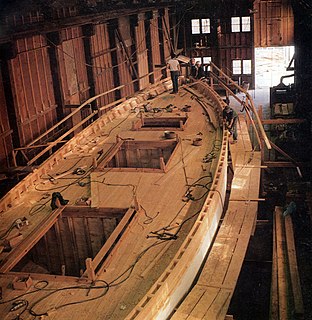
Boat building is the design and construction of boats and their systems. This includes at a minimum a hull, with propulsion, mechanical, navigation, safety and other systems as a craft requires.

A gig is a type of boat optimised for speed under oar, but usually also fitted with a sailing rig for appropriate conditions. The type was in use by Deal boatmen in the 18th century. It first occurred as a naval ship's boat after Deal boatbuilders recommended a different design to boats ordered from them by the Royal Navy to equip the cutters purchased in the 1760s to combat smuggling. The captains of larger warships soon sought permission to substitute a gig for one of the heavier boats which were then used; some even had a gig built at their own expense. The gig therefore became part of the usual complement of ship's boats used in warships.

Clinker built is a method of boat building where the edges of hull planks overlap each other. Where necessary in larger craft, shorter planks can be joined end to end, creating a longer strake or hull plank. The technique originated in Scandinavia, and was successfully used by the Anglo-Saxons, Frisians, Scandinavians, typically in the vessels known as cogs employed by the Hanseatic League. Carvel construction, where plank edges are butted smoothly, seam to seam, supplanted clinker construction in large vessels as the demand for capacity surpassed the limits of clinker construction..

Rowing is the act of propelling a boat using the motion of oars in the water by displacing water to propel the boat forward. Rowing and paddling are similar. However, rowing requires oars to have a mechanical connection with the boat, while paddles are hand-held and have no mechanical connection.

In watercraft, a racing shell is an extremely narrow, and often comparatively long, rowing boat specifically designed for racing or exercise. It is outfitted with long oars, outriggers to hold the oarlocks away from the boat, and sliding seats. The boat's long length and semicircular cross-section reduce drag to a minimum. This makes the boat both fast and unstable. It must be balanced by the rowers to avoid tipping. Being able to balance – or "set" – the boat while putting maximum effort into the oars is therefore an essential skill of sport rowing.
In competitive rowing, the following specialized terms are important in the corresponding aspects of the sport:

Scalloway is the largest settlement on the west coast of Mainland, the largest island of the Shetland Islands, Scotland. The village had a population of roughly 900, at the 2011 census. Now a fishing port, until 1708 it was the capital of the Shetland Islands.

Coastal and offshore rowing is a type of rowing performed at sea. Due to the harsher conditions encountered, the boats are wider and more robust than those used on rivers and lakes. In North America, this sport is often called open water rowing.

Harry Clasper was a professional rower and boat builder from Tyneside in England. He was an innovative boat designer who pioneered the development of the racing shell and the use of outriggers. He is said to have invented spoon-shaped oars.
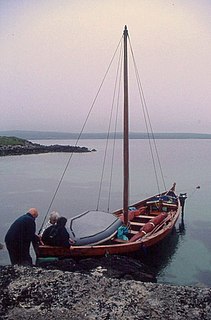
The sixareen or sixern is a traditional fishing boat used around the Shetland Islands. It is a clinker-built boat, evolved as a larger version of the yoal, when the need arose for crews to fish further from shore. The first of the sixareens were, like the yoal, imported from Norway in kit form until the mid 19th century, when increasing import duty made it more cost effective to import the raw materials and build the boats in Shetland.
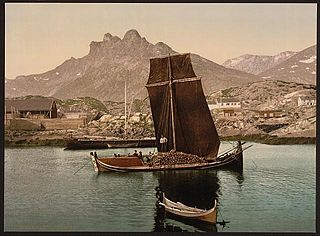
The Nordland boat, is a type of fishing boat that has been used for centuries in northern counties of Nordland, Troms and Finnmark of Norway and derives its name from Nordland county where it has a long history. It has dominated the Lofoten and Vesterålen islands fishing industry for centuries and is closely related to the old Viking longships.

A thwart is a part of an undecked boat that provides seats for the crew and structural rigidity for the hull. A thwart goes from one side of the hull to the other. There might be just one thwart in a small boat, or many in a larger boat, especially if a several oarsmen need to be accommodated.

The Oselvar or Oselver is a small wooden rowing boat traditionally built and used along the west coast of Norway. The Oselvar is a clinker built boat with thin, very wide planks. Almost all parts of an Oselvar are made of pine, with only the keel of oak.
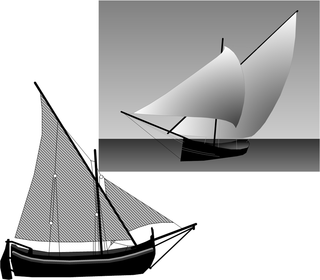
A falkusa is a traditional fishing boat used by fishermen from the town of Komiža on the Adriatic island of Vis, Croatia. Falkuša is a subtype of gajeta, a traditional Dalmatian fishing sailboat, and is sometimes called gajeta falkuša. Its design was adapted to the specific needs of Komiža fishermen, who went to long fishing expeditions in the open seas, a unique practice in the Adriatic and Mediterranean.

Yal – Russian and Soviet Naval transom stern light weight rowing-boat with one removable mast and set with the sail. A small yal is sometimes called a yalik, the diminutive form of yal.

The St. Ayles Skiff is a 4 oared rowing boat, designed by Iain Oughtred and inspired by the traditional Fair Isle skiff. The boat’s hull and frames are built using clinker plywood and it measures 22’ with a beam of 5’ 8”. It is normally crewed by four sweep rowers with a coxswain.
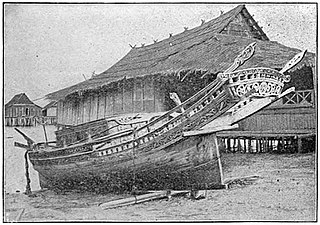
Lepa, also known as lipa or lepa-lepa, are indigenous ships of the Sama-Bajau people in the Philippines and Malaysia. They were traditionally used as houseboats by the seagoing Sama Dilaut. Since most Sama have abandoned exclusive sea-living, modern lepa are instead used as fishing boats and cargo vessels.
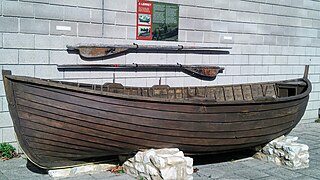
A lerret is a type of rowing boat designed for use off the Chesil Beach in Dorset. It is of wooden, clinker construction and varied in size, depending on the number of oars – the largest would have up to eight. It was primarily used for fishing but, in emergencies, lerrets would be used as lifeboats.





















